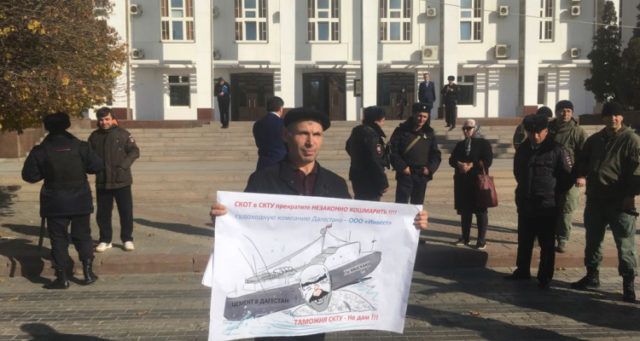
Dagestan Rocked by Unprecedented Wave of Demonstrations
Publication: Eurasia Daily Monitor Volume: 14 Issue: 151
By:

One of the most dangerous times for almost any society is when new leaders decide to launch reforms. On the one hand, elites and even portions of the society that have benefited from past arrangements are certain to try to defend what they have. And on the other, both those who will benefit from announced reforms and those who hope for additional change are likely to go out into the streets to press their case. Each of these groups are generally confident that the new leaders will not crack down on them hard. The expectation is often that the new leadership will be happy to make use of such street energy against local elites; or the authorities may fear that any repressive actions could prove counter-productive. Either way, this is likely to drive still more people to demonstrate, leading to an uncontrolled situation.
This is precisely what now appears to be happening in Dagestan—the most Muslim and multi-ethnic republic in the North Caucasus—in the wake of President Vladimir Putin’s installation of Vladimir Vasilyev, an ethnic-Kazakh-Russian outsider, as acting governor on October 3 (see EDM, October 13). And this development is important not only for Dagestan itself but for Moscow’s policies toward other non-Russian republics (see EDM, November 17, 20). Given that the Kremlin had calculated that its new man could carry out changes without the risk of provoking opposition, the exact opposite has been happening so far. Indeed, to the extent that unrest spreads in Dagestan, President Putin is likely to be less willing to try to change more heads of republics anytime soon, putting off such reshuffles at least until after the March 2018 presidential vote.
In the six weeks since arriving in Makhachkala, Vasilyev has unsettled the political elites there with three policy announcements. First, the new republican head declared that the long-standing arrangement of allocating positions according to ethnic quotas, a policy that simultaneous promoted stability but also stagnation in Dagestan, had come to an end. From now on, Vasilyev said, he would select leaders on the basis of their competence rather than their nationality. Second, he has said that leaders at all levels must address the problems of the population rapidly or face equally rapid dismissal, a demand that has already led to shakeups in the composition of the central republican government and many provincial ones. And third, he has instituted a crackdown on the corruption that was endemic under his predecessor, Ramzan Adulatipov, a step made even more necessary because of increasing budgetary stringencies (Regnum, November 13).
Not surprisingly, he has been resisted by many in the local power structure and by members of the ethnic groups that benefitted from the previous arrangements. Some of them have aired their grievances openly. But most have either sought to press their cases in private meetings with Vasilyev or to try to wait him out via a slow defensive war of attrition, confident that the new broom will sweep only for a time, that the republic head cannot deal with everything he wants immediately, and that they will survive to fight another day. The clearest signs of their resistance so far have been Vasilyev’s own pointed statements about his intentions with regard to such officials (Regnum, November 13).
The public demonstrations, meanwhile, have been far more visible. Dagestanis have gone into the streets across the republic to demand attention to their problems from the new leader. As local commentators stress, their demands are about everyday problems rather than major political change. Some want housing to be restored after a fire, which Abdulatipov did not do. Additionally, they are asking for better schools, the resolution of land disputes, the improvement of schools as well as fairer treatment of Muslims as opposed to Orthodox Christians, who have tended to routinely win favor from the authorities in recent times. Finally, and most generally, the demonstrators want their republic government to pay attention to them, something most are convinced the previous regime did not do (Chernovik.net, November 13, 17; Onkavkaz.com, Nazaccent.ru Kavpolit.com, November 13).
Local commentators, like Magomed Magomedov of Chernovik and Milrad Fatullayev of the Derbent News Agency, are at pains to suggest that the rise of demonstrations in Dagestan is part of a broader growth in protest activity across Russia linked to the election. They further argue that it reflects hope that the new leader will be able to address their problems in ways that a previous leader had been unable to (Kavkazsky Uzel), November 15). At the same time, they stress that, so far anyway, the protests and demonstrations in the cities and villages of Dagestan are not political in the usual sense.
But two other Dagestani writers, Mairbek Agayev and Saida Vagabova, are not so sure that things will stay that way for long. They note that Vasilyev, like any new leader, has entered office with a certain amount of credit—initially, the population broadly assumes that he will at least try to do the right thing. But unless the new republic head can deliver and deliver quickly, the situation will change. Everyone must understand, they write, that “the incubation period of distrust for the leader of the republic is extremely short; and with each new head of the region, even that period is reduced in length” (Chernovik.net, November 17).
If they are right, Vasilyev could soon face a political challenge from the streets much as Abdulatipov did—something at least a few in Dagestan’s traditional elites are hoping for and that Moscow has good reason to fear.



